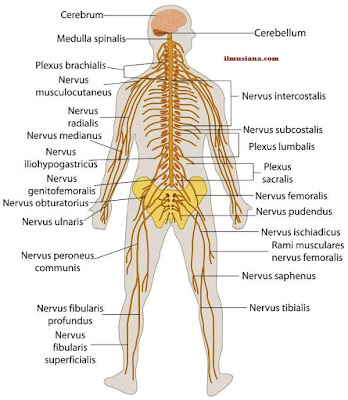Human nervous system is composed of sensory receptor of the sense (nerves which are located in the five senses), stimulus transmitter that transmits stimulus to the nerve center (sensory nerver), the central nervous which sorts and interprets the stimulus information, and motor nerve that transmits message from central nerve to effectors.

Human Nervous System

Read: Reproductive System Human BodyStimulus comes from out of the body and received by sensory receptors of the sense eyes, nose, tongue, ears and skin. The information that is received by the nerve ends of the senses then will be changed to impulse, like weak electricity current. Impulse then is transmitted by sensory nerve to the central nervous. The central nervous then interprets the information from the sense to be a message. This messge that is called impulse is also transmitted to the effectors (e.g. muscle) by motor nerve. Muscle that receive order from the central nervous then do their job as a response to stimulus. Based on their function, nerve is classified to:
- Sensory nerve, nerve that transmits impulse from the sensory nerve ends to the central nerve.
- Central nerve, brain and spinal cords.
- Motor nerve, nerve that transmits impulse from central nerve to the end of nerve that is placed on effectors (e.g. muscle).
- Interneutron, it is composed by connector and adjuster. Connector nerve is nerve that connect one nerves to the others, whereas adjuster nerve is nerve that connect sensory neuron to motor neuron and placed on central nerve.
Nerveous Cell Arrangement
Nervous system is composed of nervous cells (neurons). Each nervous cell is composed of dendrite, cell body and axon (neurite).- Dendrite is formed by elongation of the nerve cell body forming some short branches. Dendrite is used to receive impulse which then is transmitted to the cell body.
- Nerve cell body is a part of nerve cell that has cytoplasm and nucleus.
- Axon (neurite) is elongation of nerve cell body; it is longer than dendrite, usually just one for each cell. Axon has some layers of coat called myelin sheath. Myelin sheath is composed of Schwann cells. Axon is not fully covered by myelin sheath, so there are some uncovered space. Spaces between Schwann cells are called node of Ranvier.